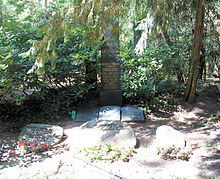Galerie Nierendorf
The Galerie Nierendorf is a commercial art gallery based in Berlin.
Artworks[]
Founding and early years[]

The brothers Karl (1889–1947) and Josef (1898–1949) Nierendorf founded Nierendorf Köln Neue Kunst in Cologne in 1920.[1] In 1925 Josef Nierendorf moved the gallery to Düsseldorf for a year. Karl Nierendorf had already taken over the graphic cabinet from I. B. Neumann[2] in Berlin in 1923 and transformed it into the Neumann-Nierendorf Gallery in 1925, which he and his brother Josef ran under this name from 1926, from 1933 as the Nierendorf Gallery.[3] As in the Rhineland, the Nierendorf brothers also exhibited expressionist art in Berlin, by artists such as Otto Dix and the Brücke artists Erich Heckel, Emil Nolde and Karl Schmidt-Rottluff.[4] Even unknown up-and-coming artists such as the student and later painter and art teacher Lorenz Humburg, Karl Blossfeldt or the neo-objective painter Ernst Thoms got a chance at Nierendorf. The gallery owners saw themselves as patrons, sponsors and publicists of the artists they represented.
Karl Nierendorf suffered serious heart attack in 1934.[5]
Berlin to New York[]
In 1936 Karl Nierendorf went to the US and opened the Nierendorf Gallery in New York in January 1937, on 53rd Street; his brother continued to run the Berlin gallery alone until 1939.[6] When Josef was drafted into the Wehrmacht, he had to give up the business. Karl Nierendorf became an American citizen and the gallery grew, especially with emigre artists such as Lyonel Feininger, Kandinsky, and Klee. He also helped emerging American artists such as Perle Fine, Adolph Gottlieb, and Louise Nevelson.[7] He died of a heart attack in 1947. His estate was sold by the state of New York to the Solomon R. Guggenheim Museum.[8] Josef Nierendorf died in 1949.
Controversies concerning Nazi-looted art[]
The Galerie Nierendorf has been involved in several cases of suspected Nazi-looted art. These include:
- "Two Nudes (Lovers)" by Oskar Kokoschka which had belonged to the Jewish collector before Otto Kalllir sold it to the Galerie Nierendorf[9]
- Zirkusreiter (Circus rider) by Max Pechtstein which had belonged to the famous Jewish art dealer Alfred Flechtheim[10]
- "Foxes" by Franz Marc which had belonged to the Jewish art collector Kurt Grawi[11]
- "Marschlandschaft mit rotem Windrad" by Karl Schmitt-Rottluff which had belonged to Max und Margarethe Rüdenberg[12]
Writing[]
- Kunstblätter der Galerie Nierendorf, Verlag Galerie Nierendorf
- Anja Walter-Ris: Die Geschichte der Galerie Nierendorf. Kunstleidenschaft im Dienst der Moderne. Berlin, New York 1920-1995. Freie Universität, Berlin, Diss., 2003.
- Yvonne Groß: Zwischen Dix und Müller – Der Berliner Kunsthändler Florian Karsch und die Galerie Nierendorf, Berlin, Lexxion Verlagsgesellschaft, 2014.
External links[]
- Website of the Galerie Nierendorf
References[]
- ^ "Galerie Nierendorf". www.artland.com. Retrieved 2021-05-13.
- ^ "Collections Online | British Museum". www.britishmuseum.org. Retrieved 2021-05-13.
- ^ "GALERIE NIERENDORF". nierendorf.com. Retrieved 2021-05-13.
- ^ "The Guggenheim Museums and Foundation". The Guggenheim Museums and Foundation. Retrieved 2021-05-13.
- ^ "The Guggenheim Museums and Foundation". The Guggenheim Museums and Foundation. Retrieved 2021-05-13.
- ^ "The Guggenheim Museums and Foundation". The Guggenheim Museums and Foundation. Retrieved 2021-05-13.
- ^ "The Guggenheim Museums and Foundation". The Guggenheim Museums and Foundation. Retrieved 2021-05-13.
- ^ "Collections Online | British Museum". www.britishmuseum.org. Retrieved 2021-05-13.
- ^ "Jewish Collector's Heir Loses Claim to Painting". www.lootedart.com. Retrieved 2021-03-29.
During the war, Dr. Reichel and his wife, Malvine, were forced to close their business and give up their family home and another property. Their oldest son was deported to Poland, where he was killed, and Malvine was sent to the Theresienstadt concentration camp in 1943. Dr. Reichel died of natural causes that same year. Kallir ended up in New York, where he sold "Two Nudes (Lovers)" to the Nierendorf Gallery for $1,500 in 1945. The painting traded hands two more times before it was bequeathed to the museum in 1973.
- ^ "Raubkunst-Verdacht erregt in Witten die Gemüter - Suspicion of looted art in Witten". www.lootedart.com. Retrieved 2021-03-29.
- ^ "Düsseldorf steht vor heikler Raubkunst-Frage - Dusseldorf faces a delicate question of looted art". www.lootedart.com. Retrieved 2021-03-29.
- ^ "Beratende Kommission für die Rückgabe NS verfolgungsbedingt entzogener Kulturgüter, insbesondere aus jüdischem Besitz Geschäftsstelle: Deutsches Zentrum Kulturgutverluste, Humboldtstraße 12, 39112 Magdeburg Empfehlung der Beratenden Kommission in der Sache Erben Rüdenberg ./. Stadt Hannover" (PDF).
- Art galleries established in 1925